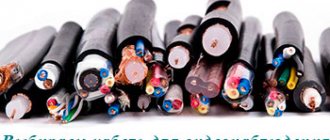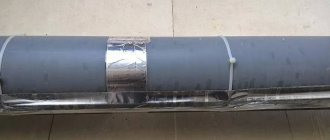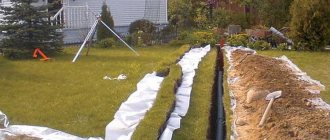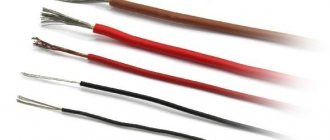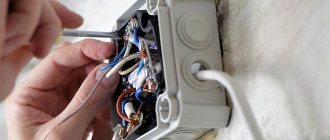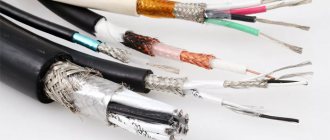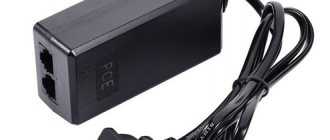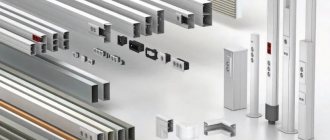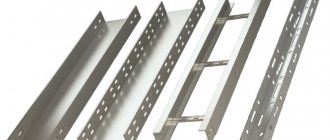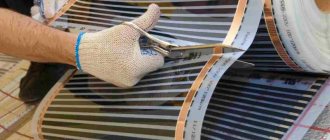Cables for a video surveillance system are traditionally considered a consumable item: a cheap and simple component compared to “mini-computers” DVRs, video servers, various types of cameras and hard drives.
According to statistics, poor-quality or incorrectly selected cables, as well as an ill-conceived power supply system, are the main sources of system failures and early “death” of equipment. Distances from cameras to the recorder of more than a “comfortable” 30 meters also impose certain requirements on the choice of cable - sometimes not entirely obvious.
Cable variety. Why is the right choice so important?
The technology used to transmit video signals from one location to another is one of the most important components of a CCTV system. The market offers many solutions for connecting components into a single whole. Here are some popular options:
- twisted pair network cable;
- coaxial cable and its varieties;
- high-tech fiber optic cables;
- wireless video transmitters and receivers.
A faulty camera can be replaced under warranty. Freezing DVR - reconfigure. Network connections are easy to reconfigure. But if, after installation, an inexpensive and seemingly simple cable refuses to work, then you will have to first find the problem and then start all over again.
The article will tell you how to choose such a cable, the intricacies of installation, connections and permissible distances. The “picture” will definitely appear on the screen even from a camera several hundred meters away, if you study the tips given. An additional bonus is recommendations for connecting a TV, monitor and other popular devices to video surveillance. Although the article is intended for a non-specialist user, we will be glad if an experienced professional learns something new for himself.
How to connect to a digital video recorder?
It is not possible to directly connect an analog camera to a digital video recorder, router or computer network card. The first step is to acquire special transmitters that allow you to convert an analog signal to the TCP/IP protocol. It is with the help of such transmitters that the analog signal will be converted to digital. You will also need a twisted pair cable with a standard connector pinout (the crimping procedure is similar to IP cameras and other devices operating using the same protocol).
The first difficulty may arise when converting an analog signal to a digital one; a regular adapter is clearly not enough. The choice of suitable equipment for signal conversion can also cause difficulties; not all analog-to-digital converters will produce good video quality and stable operation; when using the cheapest devices, the quality of shooting can suffer greatly
The procedure for connecting and configuring devices is as follows:
- The first step is to install the video camera and connect it to a power source.
- Connect the camera to the converter (receiver) using a coaxial cable.
- Connect the transmitter to your computer's network card, recorder or router via a category 5 cable (twisted pair). If the cable is category 5 without connectors, first crimp it according to the appropriate diagram (for connecting to a PC the diagram will be “computer-to-computer”, for connecting to a recorder or router “computer-to-hub”). Although for most modern IP cameras the connection diagram is not critical. When using a router, you may need to open additional ports through the router settings.
- The device to which the A/D converter is connected will need to be configured. When connecting to a PC or router, you need to open a browser and enter the IP address of the transmitter (indicated in the instructions or on the device body), this is done on the recorder in the appropriate settings. It is strongly recommended to change the standard IP, login and password for security purposes, otherwise the cameras may be hacked by malicious people.
- The image is displayed and you can start recording. For ease of use of cameras, it is recommended to install specialized software for video surveillance on computers (using a regular browser for such purposes is not recommended).
Coaxial cable for video surveillance
A popular and completely reliable way to transmit video signals. It consists of a coaxially located, i.e. having a common axis, a central conductor and a braided screen. In this case, the video signal itself passes through the central core (the so-called asymmetrical transmission ), and the screen is used to equalize the zero potential, as well as to protect the central core from external electromagnetic interference.
Coaxial cable is classified primarily by the type of characteristic impedance, which is measured in Ohms. There are two main standards - 50 Ohms for transmitting radio signals and 75 Ohms for video signals. The latter is precisely used in video surveillance systems, as well as in cable and satellite television.
The central conductor can be made of high-quality purified copper, which allows the signal characteristics to be preserved over long distances.
The dielectric allows you to maintain the common axis of the central core and braid even when bending and, as a rule, is made of various types of polyethylene. The screen consists of double-sided aluminum or copper foil and braid. The sheath is available in two types: for outdoor installation, this cable is black in color and is resistant to the external environment (frost, sunlight, burial in the ground, etc.) and for indoor installation - white or gray. The cable is used to pass a cable through the air, for example, between houses or other structures. One of the most inexpensive types of cable with a characteristic impedance of 75 Ohms is RG-59 and RK-75 . They have a small diameter and are very convenient for installation. RG-6 cable is used at distances over 200 meters. SAT coaxial cable has less signal attenuation and is used for laying over even longer distances. The RG-11 trunk cable (thicker and more expensive) is used to transmit signals over 600 meters, as well as for installation in difficult conditions.
The table shows the parameters of the most common cable types. The “maximum distance” parameter is given for the case of transmitting an unmodulated video signal in the so-called baseband.
| Characteristics | RG-59 | RG-6/U | RG-11/U |
| Maximum video signal transmission distance, m | up to 200 | up to 450 (b/w) | up to 600 (b/w) up to 400 (color) |
| Wave impedance, Ohm | 75±3 | 75±3 | 75±3 |
| Diameter of internal conductor, mm | 0,6 – 0,81 | 1 – 1,1 | 1,5 – 1,63 |
| Temperature range, average | -10°C to 40°C | -20°C to 50°C | -40°C to 80°C |
| Approximate cost, rub. for 1 m. | 8 – 45 | Sold in coils | Sold in coils |
By the way, RK (radio frequency cable) is one of the domestically produced models. They, like their foreign analogues RG, also have their own “science” of marking. RK-75 means “radio frequency cable with a characteristic impedance of 75 Ohms.”
| Characteristics | RK-75-1.5 | RK-75-2 | RK-75-3 | RK-75-4 |
| Maximum video signal transmission distance, m | up to 50 | up to 100 | up to 250 | up to 400 |
| Wave impedance, Ohm | 75±3 | 75±3 | 75±3 | 75±3 |
| Diameter of internal conductor, mm | 0,24 | 0,37 | 0,6 | 0,72 |
| Approximate cost, rub. for 1 m. | 6 – 15 | 7 – 15 | 14 – 30 | 25 – 50 |
When transmitting a color signal, the indicated distances should be divided by 1.5.
If a larger length is required, you can use special additional devices - video amplifiers. They are designed to amplify and equalize fading video signals. Depending on the quality of such a device, the cable length can be increased by 1.5 - 2 times.
Coaxial cable installation guidelines
In order to protect yourself from most problems when laying this type of cable, you must adhere to the following rules:
- Avoid laying wires parallel to the power ones and do not place them closer than 30 cm to each other. Noise from the electrical network may take the form of several horizontal stripes on the monitor screen that slowly move down (or rise up);
- Avoid loops and bends in the cable during installation, as they disrupt its uniformity, which can lead to the loss of small parts of the picture or doubling of the image. The image quality will be better if the loop bend is at least 5 times the diameter of the coaxial cable. During operation, the central wire may break off at a bend, which will lead to a complete loss of the video signal;
- Use only a single piece of cable and under no circumstances use so-called “twists”;
- To reliably connect video system components, it is recommended to use special BNC connectors, and leave a sufficient supply of cable in places of future connections.
BNC connectors
In video surveillance, special connectors are widely used to connect coaxial cable to cameras, DVRs, or connect two cables to each other. The most common are BNC connectors. They come in three types - crimped, soldered and threaded.
The experience of many installers has shown that crimp connectors are the most reliable. Their connection order is as follows:
- Carefully cut the outer layer of cable insulation with a sharp knife - about 20-30 mm from the end;
- Place the metal sleeve over the insulation;
- Bend the braid (screen) back towards the insulation;
- Cut off the translucent plastic of the dielectric, in the center of which the signal core is located;
- Place a BNC connector onto the copper core. The “screen” braid is evenly applied over the connector;
- We move the metal sleeve to the end of the wire so that the braid is underneath it. The coupling is fixed to the connector using a special tool (it is not recommended to use pliers for this). The BNC connector is ready to be connected to the recorder.
We will tell you more about this type of connector in the next article.
Which one is better to choose?
Which cable to choose for a video surveillance system?
Typically, choosing the right type of CCTV cable depends on your specific situation, your desires and the cameras you choose. In the case of IP cameras, this is almost always the unambiguous use of a UTP cable with RJ-45 connectors; analogue video surveillance with a small number of cameras can get by with a regular coaxial cable at distances not exceeding 100-300 meters, and to be able to supply power and transmit signals over one cable it is necessary use either a combined video surveillance cable with power or twisted pair cable. If you have a large number of cameras and longer distances, we would recommend using a twisted pair cable - UTP, FTP or STP cable - depending on the distances, location of use (outdoors, indoors) and sources of interference.
The differences in the location of communications will be that for external cameras it is necessary to use a cable with protective external insulation made of solid polyethylene, and for internal video surveillance systems it can be taken from ordinary PVC. Also, a cable for outdoor installation may have a steel support cable in its design, which is necessary to enhance the strength of the cable when laying the cable through the air (KVK-Pt).
In this article, we tried to analyze as much as possible the question of how to choose the right cable for video surveillance, talked about the main types and their characteristics, tried to highlight in as much detail as possible those design differences that play a major role in choosing the most suitable cable depending on a particular CCTV systems and your preferences. We wish you good luck and hope that this material remains useful to you!
With this they read:
Microphone for CCTV camera: selection criteria, types and current models
Dummy CCTV camera
Ready-made video surveillance kits for various needs: selection tips with examples
Choosing a hard drive for video surveillance
Did you like the article? Share with friends on social networks!
- Ilya
04/14/2017 at 12:09good afternoon!!! The distance to the cameras is 160 meters!!! what cable should I use? did you want a regular home twisted pair cable or is it too far?
Reply ↓
Alexander Starchenko
(Post author)04/18/2018 at 05:25
Hello, Ilya. You can use a repeater every 80 meters, but AHD and TVI digital cameras would be better. They now have a resolution of up to 5 megapixels, a range of up to 500 meters.
- Anonymous
03/24/2019 at 03:25
there are laser cameras up to several kilometers
04/17/2017 at 12:21
you need cable RK-75-2-13—100 meters. Is it available and how much does it cost?
Reply ↓
- Alexander Starchenko
(Post author)04/18/2017 at 05:34
Hello, Sergey! The cost of this cable from various sellers ranges from 10 to 30 rubles/meter.
07/08/2017 at 17:02
Thanks informative!
Reply ↓
07/23/2017 at 12:44
hello, tell me how to connect the camera to the video intercom, the camera has 4 pairs of colors and there are two wires coming out of the video intercom
Reply ↓
- Alexander Starchenko
(Post author)08/05/2017 at 17:46
Hello. Not every video intercom can connect a video camera; read the instructions for the intercom.
08/07/2017 at 11:50
hello, please tell me, we connected the camera via UTP twisted pair cable, the distance is 10 meters, and the picture is rippling! But at night it doesn’t show!! The cameras were changed, the signal amplifiers were installed, everyone has already changed their minds, there is no electrical wire nearby, everything is connected clearly and perfectly, checked inside and out several times!!! Has anyone come across this?
Reply ↓
- Alexander Starchenko
(Post author)08/12/2017 at 12:31 pm
You need to check using the KVK or RK75 cable, if the ripples stop, then the problem is in the cable, and if not, then the camera needs to be returned under warranty
08/21/2018 at 14:20
Your symptoms hinted to me that the power supply unit. poor. There is a possibility that there is a power drawdown during the day, and at night due to the backlight there is a complete failure.
02/20/2020 at 06:43
If it doesn’t show at night, then there is a possibility that there is not enough current from the power source and when the LEDs are turned on, the camera falls off
01/03/2021 at 23:17
Check the operating temperature of the camera, we toiled for a whole week and it turned out that at night the temperature drops below minus 20 degrees and the camera stops working, this also happens, and about the power supply as a possible reason, make sure that it is in order, for cameras designed for 12 volts the operating range is from 11 .3 volts to 14 volts
08/26/2017 at 09:31
Good afternoon. And with what characteristics should you use a UTP cable when connecting IP cameras powered by PoE technology. The maximum distance to the cameras is 40 m.
Reply ↓
- Alexander Starchenko
(Post author)09/12/2017 at 10:30
Good afternoon. For 40 meters you can use any cable, the distance is not long.
10/18/2017 at 12:22
Hello, I need to connect 8 cameras on the street, the cameras will be on poles around the area, but I don’t know which cameras need to be taken so that I can use twisted pair, but twisted pair (with foil insulation) but RJ-45, is there such a thing? And how to connect everything into one circuit, hook up the adapters on the branches to the cameras? Thank you.
Reply ↓
- Alexander Starchenko
(Post author)10/26/2017 at 07:37
IP cameras are connected via twisted pair, RJ-45 is a universal connector used in UTP, FTP, STP cables.
10/25/2017 at 12:12
Good afternoon! Please tell me I have a cable for IP cameras. They burned out. Can I put analog cameras on these wires? Thank you in advance
Reply ↓
- Alexander Starchenko
(Post author)10/26/2017 at 07:40
Good afternoon, yes you can.
12/12/2017 at 11:35
Good day! Tell me, I have a combined cable with power supply of 10 meters, can I extend the cable with a simple antenna to the TV?
Reply ↓
- Alexander Starchenko
(Post author)12/13/2017 at 05:23
Hello. Yes you can, with a resistance of 75 ohms.
12/12/2017 at 22:15
Hello. I connected the HD-TVI camera to the DVR via twisted pair cable. Distance 10 meters. The signal does not pass through, the recorder does not see the camera. What can be wrong?
Reply ↓
- Alexander Starchenko
(Post author)12/13/2017 at 05:24
Hello, Vladimir. You need to use TVI converters for twisted pair, or connect with a coaxial cable.
03/11/2018 at 18:30
Hello, I have a camera with two tulip connectors (yellow and red) and a power connector, please tell me which cable is more suitable for connection. Distance 10 meters.
Reply ↓
- Alexander Starchenko
(Post author)04/18/2018 at 05:27
Hello Aram. A coaxial cable will suit you, maybe with a transition to BNC.
03/19/2018 at 11:40
Can you tell me how to crimp 2-pair UTP to connect a video recorder and a computer?
Reply ↓
- Alexander Starchenko
(Post author)04/18/2018 at 05:28
A DVR is like a computer. Accordingly, if directly, then a cross connection, if through a hub, then direct crimping.
04/05/2018 at 15:06
Hello, please tell me which of the 8 wires can be used to power IP cameras. There is no PoE, we just saw how 2 wires from UTP are separated and the power supply is simply connected.
Reply ↓
- Alexander Starchenko
(Post author)04/18/2018 at 05:28
Hello. The blue pair is entirely for minus power, the brown pair is for plus power. Direct crimping (hub-computer).
04/15/2018 at 18:03
Good evening, please tell me. 3ip cameras are connected to the switch. From the candle there is a loco transmitting point at a distance of 200 meters. We use UTP cable on the cable. What problems might arise? Will distance affect signal transmission?
Reply ↓
- Alexander Starchenko
(Post author)04/18/2018 at 05:25
Hello, Alexander. It is better to use a response point not loco, but a full-fledged one in bridge mode. And you need direct visibility. There should be no other problems, the scheme is working.
05/17/2018 at 22:13
Is it possible to run a KVK cable underground in a metal pipe at a distance of 70 meters?
Reply ↓
- Alexander Starchenko
(Post author)05/22/2018 at 10:15
It is possible, as long as the pipe is sealed. Usually HDPE pipe is used, it is without seams.
05/19/2018 at 07:45
Hello. I connected the KPC-EX190SHB1(H-Res) video camera. The camera shows well, but does not last long. The camera soon becomes very hot and wide black stripes appear in the video. The instructions say that it is important that the current is no more than 80mA.
Reply ↓
- Alexander Starchenko
(Post author)05/22/2018 at 10:14
Hello. In the early 2000s, there were cameras that operated only in pulse mode, based on a motion sensor; the same ones were used in video intercoms; they were a little cheaper. You either have a camera malfunction or a pulse camera. It is better to replace it with a more modern AHD.
05/19/2018 at 12:15
Good day, the problem is this: the object has been adjusted, 15 cameras need to be installed, but the cameras are used, the distance to the farthest camera is 300-350 meters, do I need to install amplifiers and at what distance
Reply ↓
- Alexander Starchenko
(Post author)05/22/2018 at 10:13
We tested it on AHD Space technology cameras, the cameras worked normally at a distance of 250-320 meters. These cameras are currently on sale in May and cost 850 rubles each! They have a resolution of 1 megapixel, naturally colored, with night illumination, outdoor, with a stated distance of up to 500 meters. It would be better to replace analog cameras with long-range ones.
05/23/2018 at 10:28
Good afternoon I bought 6 ST-1045 AHD cameras, I’m trying to connect via twisted pair, the signal doesn’t come to the recorder, I bought passive transceivers, it still doesn’t work. What can be wrong
Reply ↓
- Alexander Starchenko
(Post author)05.25.2018 at 07:24
Good afternoon. ST-1045 cameras are connected via coaxial cable: RK-75, KVK or similar. If you do not have the opportunity to use coaxial, then at your own peril and risk you can connect twisted pair cables through specialized transceivers for the AHD signal. Transceivers for analog signals are not suitable. And remember that this combination very strongly picks up any interference, for example from a 220V network. Therefore, place the twisted pair cable as far as possible from the source of interference (other cables). In addition, make sure that the recorder input is turned on in AHD mode
05/24/2018 at 13:40
Good afternoon Is it possible to use an SFTP cable to connect cameras by laying it in a pipe underground?
Reply ↓
- Alexander Starchenko
(Post author)05.25.2018 at 07:27
Good afternoon You can use a sealed pipe, for example HDPE.
05/25/2018 at 19:15
Good afternoon. There is a need to create a temporary video surveillance system at the site. 10 cameras. Distances from the recorder from 30m. up to 600m. The question is what is the best way to do it (cameras on poles, power will not be supplied to the poles).
Reply ↓
- Alexander Starchenko
(Post author)05/27/2018 at 09:24
Hello, Rinat. Clarify your question, what do you mean when you say “what is the best way to do it?” What cameras are you going to use - analogue or IP?
05/27/2018 at 16:38
Hello, is it possible to connect several cameras on one shielding wire and the central wire separately? Thank you.
Reply ↓
- Alexander Starchenko
(Post author)05/28/2018 at 05:24
What cameras are you going to connect? In general, the grounding conductor can be combined.
06/01/2018 at 23:40
Hello, we have an IP camera with a distance of 250m. The recorder does not see it, the cable rings and the power comes to the camera. The camera is registered and tested on a short cable. The switch produces three short signals with a pause and repeat. What should I do? Thank you in advance
Reply ↓
- Alexander Starchenko
(Post author)06/02/2018 at 06:09
IP cameras operate at a distance of 80-100 meters. At 250 you can use AHD cameras. If you want IP, then an option is repeaters every 80 meters or WiFi with line of sight.
06/19/2018 at 07:09
Hello, I have a building with 2 floors plus a roof with metal tiles, I’m going to install a total of 10 cameras inside and outside the building and one on the metal tiles, the question is which cable is better to take, just UTP and with braid, then on the floor for each camera I’m like this I understand that grounding needs to be done, I’m also going to install a passive poe injector with 16 ports to power these cameras, and then take one wire from the injector to the receiver, the distance to the cameras will be no more than 100m, thank you in advance
Reply ↓
- Alexander Starchenko
(Post author)06/30/2018 at 11:14
Hello. You have a wrong idea about the camera connection diagram. More than one wire will come from the injector. If you can provide an approximate diagram of the installation of cameras with marked places, we can make you a commercial offer. What does it mean that I plan to install a camera on a metal tile? Cameras are not installed on metal tiles; you will create a leak in the roof.
06/19/2018 at 23:08
Dear time of day! SNT, we want to install a video surveillance system at the beginning of 4 streets. From 30 to 200 meters to the registrar 0. The lines are supposed to be pulled along 0.4 kV power poles. Install the recorder next to/inside the PTS. It is advisable to turn on motion sensor cameras and at least one microphone. What are your recommendations for equipment? Thanks in advance for your answer
Reply ↓
- Alexander Starchenko
(Post author)06/20/2018 at 13:39
A total of 300 m of cable was laid. In your case, you can either save money by installing general-view cameras, or (which is preferable) install narrow-angle cameras to view each street in the distance. The latter, with a resolution of 2MP 12mm, will cover up to 30-40 meters in length. If we take similar ones with a focal length of 50mm, then their maximum operating range will be up to 200 meters.
But these cameras will no longer be able to see the 20 meters closest to the camera. Of course, such narrow-angle cameras are more expensive, 12,000-19,000 per unit. It is not advisable to install microphones outdoors; moisture condensation quickly damages them. Or are you planning indoors? If you are interested in equipment, call the phone number listed on the website.
08/02/2018 at 09:46
Hello. They gave me a regular analog camera, I installed and ran a regular military field wire twisted (black), the distance of 45 meters shows dimly and in the evening nothing at all, I installed the electrical power next to the camera. The image has not improved, please tell me what am I doing wrong and do I need to install the power supply nearby? Thank you in advance, I'm waiting for your answer.
Reply ↓
- Alexander Starchenko
(Post author)08/07/2018 at 12:48
Hello. It is better to use a KVK combined cable. A high-quality cable that allows you to transmit power up to 60 meters and a video signal up to 500 meters costs ~ 35 rubles/m. KVK cable with 0.5mm or thinner cores costs 21 rubles/m, up to 40 meters power supply, video up to 300m. But maybe it will work at 45, we need to check. Field cable P-274, field is a telephone cable, it is not intended for transmitting a video signal. As a last resort, you can use the RK-75 cable for video transmission (television).
08/08/2018 at 14:49
Hello, there are 4ip 4 MP cameras with Poe, installed on the street, at a distance of 30-150 meters approximately from the DVR. I realized that I needed an external twisted pair cable. I looked, prices range from 19 to 80 rubles per meter. Do I need to buy a screen and what kind of twisted pair cable so as not to overpay for the brand?
Reply ↓
- Alexander Starchenko
(Post author)08/28/2018 at 06:36
Hello Dmitry. A twisted pair connection works up to 80 meters (up to 100 in theory). We tried for a longer distance, the solution is: 1. Use a POE extension cable and 2. Use a P-296 cable.
08/12/2018 at 01:28 pm
Which cable should I use for microphones in a video surveillance system?
Reply ↓
- Alexander Starchenko
(Post author)08/13/2018 at 11:31
Regular twisted pair cable will do.
08/12/2018 at 13:45
There is a need to connect a camera at a distance of 500 meters, the recorder is a hybrid, it is possible to install an AHD or YR, but there is no power supply at the camera installation site. There is a solution?
Reply ↓
- Alexander Starchenko
(Post author)08/28/2018 at 06:35
Hello Arthur. It is necessary to use a KVK cable with low attenuation. We tried. In principle, 4 MP AHD at 600 meters also works, but the quality of course deteriorates. We can produce a kit with power converters for such a distance. Do you already have equipment or will you be purchasing it?
08/23/2018 at 13:42
Good afternoon. Tell. At a distance of ~260-270m from the recorder to the camera, which is better to use a cable for signal and power supply FTP with adapters or KVK? Camera 2MP HD-TVI. Thanks in advance
Reply ↓
- Alexander Starchenko
(Post author)08/28/2018 at 06:33
Good afternoon, Ivan. For 2MP only KVK and high quality, with dense copper braiding. FTP only covers a short distance and is very susceptible to interference.
09/02/2018 at 09:09
Good afternoon Alexander, sorry for the trouble, I’m installing a system for 16 cameras, everything is fine, but 8 lines are excessive in length, from 100 to 200 meters, my plan: RG59 combined cable and power supply 9 outputs 12V 30Am, output power 300-400 watts, I am plagued by doubts at such distances; will the losses be critical? , cameras with backlight 12v 2am 8 watt (manufacturer’s data), there is an idea to take a 13.8v unit, measure the output and if you install a converter for 12v, on RG59 there should be no loss of video signal (in theory), please advise what can be changed or implemented to avoid fatal errors. thanks in advance
Reply ↓
- Alexander Starchenko
(Post author)11/20/2018 at 07:28
Good afternoon, Roman! For such a distance, 13.8 V is not enough. Set it to 24 volts or 36. And 8 converters for 12 V. The cable is better than 0.75 mm.
09.14.2018 at 15:15
Good afternoon. Tell . To connect 2 outdoor video cameras, I bought 2 separate cables UTP 4PR 24AWG CAT5e OUTDOOR, 305m CCA PROCONNECT 26 meters each, I don’t know yet what kind of cameras they will be. The cables need to be laid now, SO I’M THINKING to leave it this way or add a separate power cable to each camera so that there is no interference. Or will a UTP 4PR 24AWG cable be enough for both power and video and the picture quality will not suffer?
Reply ↓
- Alexander Starchenko
(Post author)11/20/2018 at 07:30
Hello, Sergey! It is better to use a combined cable for video surveillance, for example KVK. Yes, it is more expensive, 20-40 rubles per meter. But cameras start from 800 rubles apiece and up to 8 megapixels. High-quality street 0.75 mm costs 35 per meter. Via UTP, if you connect AHD cameras, don’t add anything, interference is still possible. And the quality will still drop sharply. You can connect IP POE cameras, but they are much more expensive (from 4000 rubles) with the same quality. They are also more difficult to configure; there are delays during transmission.
10/04/2018 at 05:17
Hello, Alexander. I want to install video surveillance with IP cameras, but the problem is in a cold climate (I live in the far north). The house is private, but I don’t want to drill extra holes for cables. Is it possible to combine cameras on the street and run them into the house with one twisted cable? Please tell me what should I do?
Reply ↓
- Alexander Starchenko
(Post author)11/20/2018 at 07:31
Good afternoon, Yuri! You can if you put the POE switch in an insulated cabinet.
10/05/2018 at 10:15
Good afternoon, please tell me, is it possible to connect 2 IP cameras with separate power to one FTP cable?
Reply ↓
- Alexander Starchenko
(Post author)11/20/2018 at 07:32
Good afternoon, Evgeniy! If the power supply is separate and the cable has 8 cores, then yes, it is possible.
10/09/2018 at 15:27
Good afternoon, please advise: camera 3.0 Mega pixel AHD-H at 100 meters, twisted pair with foil insulation, huge interference, do you need grounding? Or is the cable not suitable?
Reply ↓
- Alexander Starchenko
(Post author)11/20/2018 at 07:33
Good day, Sergey! The cable does not fit. You need a high-quality KVK (outdoor) cable.
10/22/2018 at 17:03
Hello! Please tell me which cable can be run under water? Needed for underwater video shooting, preferably armored.
Reply ↓
- Alexander Starchenko
(Post author)11/20/2018 at 07:34
Hello Dmitry! You can use an outdoor KVK with thick insulation. For additional protection, you can place it inside a HDPE pipe (it will only tend to float) or a corrugated metal sleeve.
02/27/2019 at 11:01
Good afternoon!! Thank you for a very useful, short course. Former engineer. But nevertheless...advise, if possible...advise...! I have analog cameras... the cable is coaxial with power wires. They work well. There is an opportunity to replace them with “IT”... is it possible to use previously laid cables... or do they have to be replaced with twisted pair...? Sincerely!
Reply ↓
- Alexander Starchenko
(Post author)03/23/2019 at 09:54
Use modern AHD cameras, then you won’t have to change them if the cable line is in good condition.
05/17/2019 at 16:36
Analog cameras are located at a distance of 800-1000 meters. The old cable, twisted pair, became unusable under the influence of sunlight. Everything looks good, but the insulation crumbles when touched.
Reply ↓
Combination cable for video surveillance systems
In video surveillance, a KVK coaxial cable specially designed for this task is often used. This abbreviation stands for “combined video surveillance cable.” In fact, these are two cables under one sheath: a signal cable for video transmission and a two-wire cable for powering television cameras. Distances over 100 meters (relevant for a supply voltage of 12 - 14 V) do not allow the successful use of combined cables. Such remote cameras require their own separate power source.
If the cameras and recorder are located in the same room, then it makes sense to purchase an “internal” KVK cable for video surveillance in white or gray. It is not protected from moisture and temperature changes, but it is easier to install inside an apartment or office - it does not stand out as much as a black cable for video surveillance (outdoor).
When stretching the “route” outdoors over a distance of 20-30 meters, you need to use a metal cable (or a special KVK-Pt cable with a supporting steel cable inside). The cable's own weight is not so small, and in winter it can additionally become overgrown with heavy icicles. The supporting cable takes on the bulk of the structure.
Markings and characteristics
Model names consist of many letters and numbers, but do not be intimidated by convenient technical markings. Let's look at one of the name options as an example: KVK-V 2x0.5.
The letters in the KVK marking indicate the type of sheath and additional functionality of the cable:
- P – outdoor video surveillance cable, resistant to weather conditions;
- B – PVC sheath (for indoor installation);
- A - aluminum core (less desirable than copper - there is no letter designation for it);
- Pt – the presence of a supporting cable under the sheath;
KKSEV is another popular type for video surveillance systems. Its task is to transmit sound along with the picture.
The number before the letter marking (usually 2 or 4) indicates the number of additional insulated wires under the shell (for powering the camera and/or controlling the rotating mechanism).
The decimal fraction after the “cross” (x0.5) is the cross-section of the cores. The voltage at the cable output is always lower than at the input. The standard core diameter of a coaxial video surveillance cable (0.5) implies the following losses:
| Characteristics | Voltage | Description |
| Input voltage | 12 V | Common for video surveillance |
| Core diameter | 0.5 mm | Standard |
| Output voltage at cable length: | ||
| – up to 30 m | 11.9 volts | Not critical |
| – up to 50 m | 11.2 volts | Not critical |
| – up to 200 m | 9 volts | Signal loss. At such distances, external power is required for the cameras |
Without going into details of physics, we note that in video surveillance systems, a resistance of 75 Ohms is taken as the standard. The entire signal is transmitted only if this characteristic is the same at the source (camera), the data cable, and the receiver (DVR).
Recommendations for installing a combination cable
This type of cable has a large distance limitation. And even if you use, for example, KVK-V-2*0.75, it is still not recommended to use it at distances over 120 meters (at a voltage of 13.8 V). The scope of application of such cables is ordinary offices and shops (small), as well as apartments or country houses. If you still need a greater distance, it is better to use a simple coaxial cable, and to power the cameras, use separate power supplies that are installed directly in front of the cameras. It is recommended not just to use regular 12-volt power supplies, but special BRP (backup power supply) with a battery.
To connect power to the camera, special power plugs are used; one of the popular models is DJK-11K . This is a power plug with a screw terminal block for connecting 12V. The cost of such a plug is only 40-50 rubles, and it guarantees ease of installation and reliable connection. To connect a microphone, RCA screw or solder connectors are used.
Useful tips for choosing
In conclusion, we highlight the main recommendations that will help with the correct choice of cable for video surveillance:
- When installing IP cameras, the best solution is to use a UTP cable with an RJ-45 connector.
- For analogue video surveillance, the classic “coaxial” is suitable if the distance between the camera and the recorder is no more than 100-300m.
- In a situation where signal transmission and power supply are carried out via one cable, it is better to use a combined option.
- If you use a large number of cameras, you should use STP, FTP or UTP cables. Here, focus on distance and the need for protection from interference.
- For outdoor cameras, use products with a protective shell made of rigid polyethylene. When installing a video surveillance system inside various structures, a cable with a PVC sheath is suitable. If you need to mount an external system, it is desirable that the cable structure has a steel cable, which provides greater strength to the product (relevant if there is an air laying).
Sources
- https://svs.guru/videonablyudenie/komponenty/kabel.html
- https://nabludaykin.ru/kakoj-kabel-vybrat-dlya-videonablyudeniya/
- https://vektor-video.ru/kabel
- https://vsesecurity.ru/videonabludenie/kakoj_kabel_dlya_videonablyudeniya
- https://bezopasnostin.ru/videonablyudenie/videonablyudenie-po-vitoj-pare.html
- https://videostoraj.ru/videonablyudenie/kakie-byvayut-vidy-kabelej-dlya-videonablyudeniya
- https://azbsec.ru/articles/videonablyudenie/vybiraem-kabel-dlya-videonablyudeniya.html
Video signal transmission over twisted pair
Twisted pair cable can also be used as an alternative way to connect a DVR and conventional (non-digital) surveillance cameras. This method is usually used when it is necessary to lay a cable longer than 200 meters.
Video transmission over twisted pair cable works on a different principle ( symmetrical video transmission ) than in the case of coaxial cable. The “coaxial” core is the only conductor of the signal, and the only “receiver” of electromagnetic interference. As the length of this cable increases, the number of image artifacts also increases: moving horizontal and vertical stripes, delays. The cable's design resists EMI, but is ineffective over long distances. In a twisted pair, both wires receive the same noise, which is successfully canceled out by the active signal receiver. The connection diagram uses additional devices: a twisted-pair signal transmitter (located next to the camera) and the above-mentioned receiver (its location is next to the DVR).
Such transmission is also justified in the case of laying one cable to 2-4 cameras located approximately on the same side. The fact is that “couple” is not really a couple. UTP cables are several pairs of conductors (usually 4) enclosed in a single sheath. There is only one wire to the signal sources, but there is enough “infrastructure” inside it to broadcast a video stream from several cameras at once. At short distances of up to 30-40 meters, it is also possible to supply a video signal through one of the four pairs, and power through the other.
The reliability of video signal transmission over twisted pair cable is high, even if the cable has to hang outside the stable climate of the room. Rains and cold snaps are not a very serious obstacle for “indoor” UTP meters of category 5 or 5e (a cable at a lower level should not be taken even for short sections, and finding it on sale is a non-trivial task).
The only drawback of this type of transmission is that in addition to the cost of the cable, it is necessary to add the above-mentioned transmitter and receiver of the video signal to the total cost, and if any of these devices fails, the transmission of the video signal will also stop.
However, this disadvantage is compensated by long distances: for passive transceivers it is up to 600 meters, and for active ones up to 2400 meters.
twisted pair
UTP cable for video surveillance, or “twisted pair”
We usually resort to using twisted pair in cases where the range of the proposed line from the camera to the signal receiving device is from 300 to 1000 m (the distance of possible laying of a working video surveillance line using twisted pair can be up to 3 km). The convenience of using this type of cable for video surveillance systems lies in the large number of conductors under one braid. Thanks to this, it is possible to supply power to the cameras via one line, and transmit the main signals (video, audio), and use the remaining wiring to provide camera control, as well as to connect an additional camera (there are enough conductors in the cable - 8 pieces).
Depending on the structural features, there are several types of twisted pair cables - UTP, FTP, STP.
- UTP cable is the simplest, it does not have protective shielding shells, and consists of 8 insulated, twisted pairs of conductors placed in a common protective shell. The disadvantages of UTP cables include their low resistance to interference, therefore, in cases of laying communications for video surveillance near electrical wiring and other sources of interference, it is better to use cables with additional protection.
- The FTP cable is distinguished by the presence of a common foil shielding sheath. Thanks to its presence, this cable can be laid close to electrical wiring cables and other sources of interference. It is very important to ensure the safety of the foil screen and not exceed the minimum bending radius - no more than 8 outer diameters of the cable. External cable protection can be made of either PVC or solid polyethylene.
- The STP cable also has a common protective sheath, but is no longer made of foil, but of copper braid. In addition, each conductor in such a cable is solid copper, insulated with polyolefin, and has an individual protective shield made of foil. External insulation is usually made of fire-resistant PVC. The use of this type of cable is necessary in cases of laying over 90 meters in the presence of numerous sources of interference.
When laying STP cable, it is necessary to ground the screen, otherwise it will act like an antenna attracting electromagnetic radiation!
Twisted pair cable for CCTV cameras is quite easy to lay and connect, so in cases of frequent changes in the video surveillance structure, as well as when connecting a large number of cameras over long distances, we recommend using a UTP cable.
The undoubted advantage of twisted pair is the large number of conductors, which ensures the connection of all main functional elements. Also, this cable has a lower cost compared to coaxial.
One source describes the experience of connecting cameras at 700 meters. Colleagues share their observations that UTP in their case collected much less interference compared to shielded FTP, so, perhaps, a UTP cable for video surveillance is the best choice in such cases. But maybe they just forgot to ground the screen, who knows...
When connecting analog cameras using such a cable, transceivers (Video Baloon) are used as an adapter, which also remove interference from the cable. We invite you to watch a very intelligible video about connecting a CCTV camera using twisted pair cable.
Cable for IP video surveillance systems
Cable for IP video surveillance with RJ-45 connector
To connect digital IP cameras, the same UTP cable with crimped RJ-45 connectors on both ends is used. Its advantage lies in the possibility of laying one common twisted pair line for an entire system of IP video surveillance cameras, using a switch. The cameras can be powered in three ways:
- Laying a separate power cable for each camera;
- Installation of power supplies in the installation locations of each camera;
- Powering cameras using loose twisted pair wires.
The third option is suitable only for cases where the camera and switch support PoE (Power of Ethernet) technology, which allows power to be supplied via an Ethernet cable for IP video surveillance; in other cases, it is necessary to use Passive PoE injectors, which allow combining signal and power transmission on both sides one cable.
Video signal over twisted pair for IP cameras
Coaxial cable is a good solution for common video surveillance systems - analog and intermediate solutions (the fashionable analog-based high-definition standard - AHD). An alternative option is a platform without a “think tank”, i.e. without DVR. These are IP cameras that transmit a signal directly to a computer or local network. This solution is beneficial when there are a small number of surveillance sources (1-3), or it is justified when broadcasting a signal over the Internet to remote users, bypassing local surveillance.
The cable for IP cameras is a twisted pair cable (other names are LAN, “network”, UTP).
Types of twisted pair:
- UTP - unshielded twisted pair without a protective shield;
- F/UTP - twisted pair is shielded by a common external foil shield;
- F/FTP - twisted pair is shielded by a common external foil shield, in addition, each pair is separately shielded;
- SF/UTP - twisted pair is shielded by a double common external shield made of copper and foil;
- S/FTP - twisted pair is shielded by a common external copper shield, with an additional foil shield on each individual pair.
Associated with twisted pair cable, the abbreviation PoE (Power over Ethernet) is a technology that provides power. Modern devices that do not require current power (cameras are among them) are able to receive electricity through the same wire from which the digital signal comes. A power source is connected to the POE adapter; the output is a twisted pair cable with a signal and electricity. Safe and convenient solution.
Technical requirements
- High-quality material from which the product is made, not underestimated resistance and cross-section. It is important to remember here that a good price does not mean good quality. TU cable is cheaper than GOST , which is due to lower quality.
- The actual cross-section of a good cable should not deviate from the declared one by more than 10-15 percent.
- EAC marking , which means that this cable complies with several dozen standards, including all necessary GOSTs.
- In addition to the label, the corresponding marking should be on the cable itself - factory marking, factory specification marking.
Currently, the requirements are regulated by GOST R 53880-2010 “Coaxial cables for cable television networks.”
Fiber optic cables: the choice for serious projects
Both analogue and digital cameras use the legendary but increasingly affordable fiber optic. Cables of this type are absolutely not subject to electromagnetic interference; the distance to the source can be measured in tens of kilometers; signal attenuation is barely present in them compared to traditional wires.
But until now, the use of fiber optic cables in the “office” and “home” video surveillance segments has more disadvantages than advantages:
- installation requires professional skills and specific tools. A non-specialist cannot do without significant costs, both in time and money;
- additional costs for fiber video receivers and transmitters in addition to the high cost of the cable itself (about 60 - 300 rubles per meter);
- poor flexibility compared to coaxial and twisted pair: light “wires” are susceptible to bending, stretching and physical impact.
Optical cable for video surveillance is successfully used in larger facilities than a house, cottage or small office. In this area, optical fiber has serious advantages. As a rule, optical fiber is used as a “means” for transmitting information, because In any case, you will need to use some signal converters (transmitters and media convectors) to connect the video camera via fiber optic.
POWER SUPPLY FOR VIDEO SURVEILLANCE
Most often, 12V power supplies are used to power CCTV cameras.
The first thing you should pay attention to when choosing a power supply is its power (operating current), which are related to each other by the following ratio:
P=I*U or I=P/U, where:
- P (Watt) - power,
- I (Ampere) - current,
- U (Volt) - voltage.
It should be noted that you need to focus on the rated values of current and power, but not on the maximum (peak).
Now regarding some of the functionality of power supplies:
Voltage stabilization.
If the mains voltage at the facility where video surveillance is installed is not subject to surges and dips, then you can use an unstabilized unit, especially since it is cheaper.
Overload and short circuit protection.
Mainly, this is necessary to protect the block itself. However, when triggered, it will turn off all cameras powered by it, and as a result, the system will freeze.
At security-critical sites, to minimize such risks, it is worth using several power sources (for small groups of cameras - a separate one) or multi-channel units with independent protection for each channel. By the way, this will prevent the possibility of mutual interference along the power circuit.
Conversion method.
All other things being equal, a switching power supply has smaller dimensions and weight than a transformer one. For high currents it is preferable.
If the video surveillance system has a small number of cameras, this may be an option with:
- private house;
- dacha;
- apartment,
It is worth considering that a low-quality pulse device can be a source of additional interference.
Multichannel power supplies.
One of the problems that may occur when operating a video surveillance system is interference in the form of stripes on the monitor screen. It can be caused by various reasons, including interference from the camera or power line.
Through the power supply, such interference can spread to all cameras in the system. To prevent this from happening, multi-channel power supplies are used, in which the video cameras are decoupled from each other in terms of power supply by various circuit solutions.
When wireless is better than wires
If it is impossible to lay wires (across the river, across the site or to a building located on the other side of the street), a wireless connection is used. But not the usual Wi-Fi, but radio broadcasting using special devices - video senders. There is also data transmission via infrared (IR) channels: in this way, a household remote control “communicates” with a TV or air conditioner. To transmit video images via infrared communication, there must be direct visibility between devices, the absence of short-term interference (passing cars, for example), and the distance should not exceed several tens of meters. Radio channels for wireless communication are a more practical type of connection.
Video sender is a set of wireless signal transmitters and receivers. Their cost starts from 50-60 dollars for a simple model (low power; broadcast distance no more than 50 meters, and only for 1-2 cameras). More expensive video senders allow you to significantly increase the distance between the signal source and its receiver (recorder, local network, etc.), as well as use a larger channel width to increase the number of cameras.
The operating principle of such devices is interesting. Neither the transmitter nor the receiver require installing drivers or additional tricks to connect cables to them (although they do require external power). The wireless device performs its task as transparently as possible: the signal is transmitted as if it does not exist at all as part of the “path”. The data simply continues to flow into the recorder, as in the classic case of direct transmission over a homogeneous coaxial/twisted medium.
Connecting wires on the DVR
Now all the video surveillance cables need to be disconnected in the low-current cabinet. First, connect the DVR itself via an uninterruptible power supply.
Then you strip the second ends of the KVK-P cable, brought into the cabinet, in the same way as shown above. In this case, connect the power wires (red and black) to the corresponding terminal blocks “+V” and “-V”.
And insert the end of the coaxial cable, with the BNC-F connector installed, into the free socket of the DVR. Where it says Video In.
Do the same with the remaining video cameras.
All you have to do is set up the video surveillance by connecting the monitor to the recorder via VGA or HDMI connectors.
If the low-current cabinet is located far from the computer, you can use a laptop to configure it. And after that, output the signal to the monitor using a separate cable.
All software for setting up video surveillance must be included with the video cameras. If for some reason it is not there, then you can try universal software, for example from ivideon.
The end section of a video surveillance system: computer network
This section probably doesn’t really relate to wiring. But it is the segment of the video surveillance platform “from the recorder to the computer (router)” that raises more questions for beginners. Paradoxically, this is also the simplest part of the system. And power supply is not required here, although it is also possible via a LAN cable - PoE technology is increasingly supported by “civilian” devices.
The video signal received from the cameras is processed by the DVR, simultaneously recorded on the hard drive inside the DVR, and, if desired by the owner, broadcast to the screen of a TV, computer monitor, smartphone or tablet. Even to the other side of the planet, if the system is connected to the Internet.
The method of connecting the DVR with surrounding computing devices (PCs, laptops, mobile gadgets) is a classic computer network. Usually - the Internet connected to the router, which is distributed to devices via Wi-Fi. At the same time, Wi-Fi connects different devices with each other. The DVR should become one of the gadgets connected to the network: from the point of view of the router, it is no different from a laptop or smartphone.
To transmit a video signal in the segment between the DVR and the router, it is enough to use a classic network cable (twisted pair) and stretch it from the DVR to the router.
And the existing Wi-Fi network can handle the broadcast of the video signal from the router to end devices (computers and mobile devices). Communication delays in this segment are minimal; stringing wires from the access point is a thankless task.
UPT categories
The international standard ISO 11801 regulates the production of UPT cables in 7 categories.
Category 1 and 2 have signal transmission frequencies of 0.1 MHz and 1 MHz. They are used exclusively for broadcasting sound in telephone communications or information via a modem. Category 3 and 4 transmit signals in the 16 MHz and 20 MHz bands and at data rates not exceeding 10 Mbit/s and 16 Mbit/s, respectively.
They are of little use for laying networks in video surveillance systems.
Category 5 and 5e are obsolete types of cables. The used frequency ranges of 100 MHz and 125 MHz make it possible to broadcast video at speeds from 100 to 1000 Mbit/s.
Cable 5e is more resistant to induced electromagnetic influences. Suitable for broadcasting video signals from analog cameras.
Category 6 and 6A - used in the list of standards since 2008. The frequency ranges used are 250 MHz and 500 MHz. Suitable for laying high-speed and megabit local networks. Suitable twisted pair cable for video surveillance in systems with a large number of digital cameras connected by a communicator or hub.
Category 7, given that according to ISO 11801 this cable has shielding of each pair and the overall braid, it is actually S/FTP. Frequency 600-700 MHz with transmission speeds up to 100 Gbit/s.
It is not practical to use it in video surveillance systems due to the high cost and interference that shielding can create.
Cables for connecting the TV to the recorder
An ordinary DVR is capable of broadcasting directly to a TV (or a separate monitor not connected to computers). And it can be more convenient to manage the recorder from the usual “zombie box” screen. There are several options for connecting a TV to the recorder, plus a nice “bonus” from the life hacks category:
- HDMI : a digital cable reliably transmits video (and audio!) over a considerable distance (in practice, up to 50 m). The cost of a meter is about 60 rubles, depending on the length. Weakly resists aggressive weather environments - this is a solution for pulling exclusively indoors;
- VGA : An ancient computer video connector that even laptops and televisions are still equipped with. VGA cables are rarely able to reliably transmit images over a distance of more than 20 meters, and they are also thick and inflexible;
- RCA : familiar “bells”, not intended for transmitting high-quality video signals, more often used to connect audio;
- wireless “mouse” : the adapter is inserted into the USB port of the recorder (not the TV!), and the cursor will move quickly across the TV screen. The most convenient way to set up/manage a video surveillance system without leaving your favorite chair! Communication range with DVR is up to 15 meters with walls.
